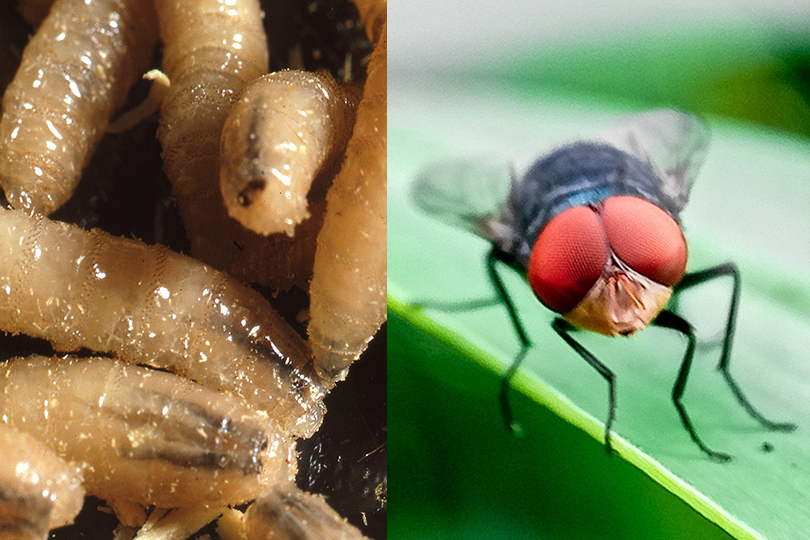
What is the New World screwworm?
The New World screwworm (Cochliomyia hominivorax) is a flesh-eating parasite that targets warm-blooded animals, including cattle, horses, sheep, goats, birds, wildlife and even pets.
Unlike other flies, the screwworm lays eggs near open wounds and mucous membranes. When the eggs hatch, the larvae burrow into living tissue, feeding as they grow—causing painful, often deadly wounds.
Once common across the southern U.S., the screwworm was eradicated from the country in the 1960s. But recent cases in Mexico have raised concern about the pest re-entering the U.S.
Identifying the screwworm
The name screwworm refers to the maggots’ feeding behavior. They burrow into the wound or tissue feeding as they go like a screw being driven into wood. Maggots cause extensive damage by tearing at the hosts’ tissue with sharp mouth hooks. The wound can become larger and deepen as more maggots hatch and feed on living tissue.
Adult screwworm flies are about the size of a common housefly. They have orange eyes, a metallic blue or green body and three dark stripes along their backs.
NWS larvae have a series of backwardly protruding spines around a tapered body, giving a screw-like appearance, helping to identify the pest.

Mexican livestock imports suspended
The U.S. Department of Agriculture (USDA) suspended livestock imports from Mexico to prevent the spread of the New World screwworm (NWS) into the U.S.
This suspension will continue on a month-by-month basis until a significant window of containment is achieved, according to USDA.
Texas Farm Bureau continues to engage with USDA staff and cattle industry leaders. While the suspension poses economic and supply chain challenges, the potential devastation of a screwworm outbreak in Texas would be far worse.
Where is the screwworm now?
The screwworm continues to move north through Mexico. The pest has been detected on Mexican farms about 700 miles from the U.S. border.
While not currently in the U.S., the proximity of confirmed cases is alarming.
Learn more about this situation on the USDA NWS Outbreak in Central America webpage.
Protect your livestock
The New World screwworm is attracted to open wounds and mucous membranes where they lay their eggs.
Any wounds should be examined for an infestation of larval flies/maggots.
It is recommended to:
- Inspect livestock daily, especially around wounds, eyes, ears, nostrils, navels, and reproductive organs.
- Treat open wounds, scratches and scabs.
- Monitor newborn livestock and breeding stock closely.
- Inspect your clothing, boots, vehicles and equipment on your farm and ranch
Signs of an infestation
Signs of an NWS infestation may include:
- Fly larvae (maggots) in wounds
- Foul odor or smell of decay
- White or cream-colored runny substance (the eggs) in and around a wound
- Bloody or light-colored drainage from a cut or wound
- A cut or wound that rapidly worsens or grows
- Irritated or unusual behavior
- Head shaking
- Fever and other signs of secondary infection
- Reduced appetite
Reporting an infestation
Early detection and reporting are critical.
If you suspect a case:
- Isolate the animal.
- Contact your veterinarian.
- Report to the Texas Animal Health Commission (TAHC) immediately.
TAHC Regional Offices (8 a.m.–5 p.m.):
- Amarillo: 806-641-7000
- Beeville: 361-358-3234
- Giddings: 979-212-5440
- Laredo: 956-568-5741
- Stephenville: 512-556-6277
- Sulphur Springs: 903-919-3748
After Hours or Weekends:
TAHC Headquarters On-Call Veterinarian: 1-800-550-8242
Additional Resources
TAHC resources
New World screwworm fact sheet
Emergency Management Guide
USDA resources
USDA webpage on New World screwworm
New World screwworm emergency response
In the news
APHIS to host New World screwworm listening sessions
USDA to combat screwworm with Texas sterile insect facility
TFB urges quick passage by Congress of ‘STOP Screwworms Act’
TFB urges support for domestic sterile fly facility
USDA suspends Mexican livestock imports over screwworm concerns
U.S., Mexico reach agreement to combat screwworm threat
USDA tells Mexico to fight screwworms or face trade restrictions
